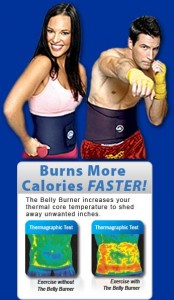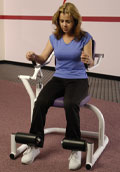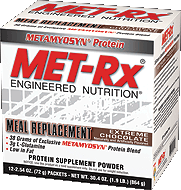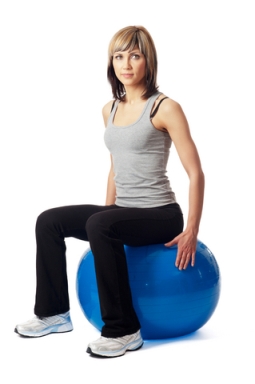
Recent Blog Posts
December 5, 2009
Fitness Fraud Alert: The Belly Burner
I was watching cable TV last night when a commercial came on the air for a product called the “Belly Burner.” I nearly dropped the cup of hot green tea I was drinking in my lap.
The ad for the Belly Burner shows several fit people securing a large neoprene belt around their waists with a promise that simply wearing the belt will help to develop “firmer, tighter, sexier abs.” Supposedly you don’t even have to exercise to see results, but the belt will “complement any exercise or physical activity: walking, biking, jogging, gym …”

The claim by the manufacturer is that the Belly Burner increases thermal core temperature, thus shedding the pounds and inches from your waist. To “prove” this claim, two thermal images with “heat vision photography” of a midsection are provided — one with with the Belly Burner, the other without it. Wouldn’t you know it, the photo using the Belly Burner shows all sorts of bright orange and yellow colors (supposedly indicative of greater heat) while the other photo is mostly a dull green and blue. Wow, some proof. Of course, as with all of these overhyped infomercials, assorted free gifts are offered including a DVD and calorie counter. Hopefully you’re not running to phone with your credit card just yet…
Let’s get down to the facts. Despite the claims, no peer-reviewed research supporting the belt’s validity is provided in the ad. None!. Based on current research, there is zero evidence to believe that the Belly Burner will have any affect on reducing your waistline. Rather, all evidence shows that you can’t increase core temperature by wearing a snug belt. At best, you might sweat a little more, which causes the temporary loss of body water — a process that is quickly reversed once you rehydrate.
Apparently the Belly Burner was invented by a “celebrity trainer” named Bobby Waldron. The ad says it used to be only available to his personal clients but now it is available to the public. Whoopee! A quick Internet search for Bobby Waldron reveals he is a model, actor, stunt man, and yes, a personal trainer. I’m not sure what order his priorities lie, but if the Belly Burner is his big contribution to the field of exercise, then he should stick with his other interests.
Unfortunately, the fitness industry is rife with hucksters that look to appeal to the naivety of the consumer with promises of an easy way to a great body. As long as there is money to be made, some entrepreneur is bound to try to capitalize for a quick buck. Don’t be scammed. When something sounds too good to be true, it usually is. By all accounts, that’s the case with the Belly Burner. Save your hard-earned money and train hard. That’s the only way you’ll get fab abs.
Stay Fit!
Brad
December 4, 2009
How Useful is the Glycemic Index?
In recent times, the glycemic index has become a popular tool to help to differentiate ‘good carbs’ from ‘bad carbs.’ Various nutritionists claim it’s the key to a lean body and entire books have been devoted to the subject. But while the glycemic index does have some utility, it isn’t the gold standard some make it out to be. First, a little background: The glycemic index was originally created to help diabetics adjust their insulin dosage. It measures the speed at which carbs enter the blood stream and ranks the foods against a yardstick (usually white bread, which has a glycemic rating of 100). Carbs that cause a rapid elevation of blood sugar (i.e. glucose) are termed high-glycemic, while those that are “time-released” and maintain stable levels of blood sugar are called low-glycemic.

The problem with high-glycemic foods is that they tend to be lipogenic (i.e. fat promoting). A spike in blood sugar levels spike causes your pancreas to release the hormone insulin to clear the sugar from circulation. Unfortunately, insulin is a storage hormone that turns on various fat storage mechanisms and blocks certain enzymes that are responsible for lipolysis (i.e. fat breakdown). When insulin levels are high, excess nutrients are more readily shuttled into adipose cells, resulting in increased levels of body fat.
Furthermore, the rush of insulin clears sugars from your circulatory system in such an expeditious fashion that it creates a rebound effect, producing a sudden and dramatic drop in blood sugar levels. A hypoglycemic state is induced, causing hunger pangs and food cravings. This creates a vicious cycle that encourages binge eating. As a result, more calories are consumed (generally in the form of high-glycemic foods) and fat storage is heightened even further.
However, simply choosing foods with a low glycemic rating won’t necessarily keep you slim and healthy. Understand that food isn’t consumed in a vacuum. A meal generally consists of a combination of different foods (i.e. chicken and rice, turkey on rye, etc) and when fats and proteins are consumed with a carbohydrate, digestion is slowed and the glycemic response is mitigated.
More importantly, the glycemic index fails to distinguish whether or not a food has nutritional value. For example, a carrot has a higher glycemic score than a Snicker’s bar, but there should be little doubt that the carrot is more nutritious. Numerous other items such as doughnuts and ice cream also have low glycemic ratings, yet by no means could they be classified as “healthy” foods. All things considered, it is misguided to solely rely on the glycemic index to guide your choice of carbohydrate.
A better way to choose carbohydrates is by their nutrient density—the amount of vitamins, minerals, and fiber in the food. By nature, nutrient dense carbs will be low on the glycemic scale and thus maintain stable blood sugar levels. But as opposed to some low glycemic foods, they also supply your body with essential compounds that enhance metabolic function. Many of the vitamins and minerals are used as co-factors that assist the body in fat burning. Others serve as antioxidants that keep cells functioning optimally. And fiber promotes satiety, decreasing the urge to overeat.
As a rule, nutrient dense carbs will be unrefined (processing removes much of the vitamins, minerals, and fiber from a food). By sticking with whole grains, and fresh fruit and vegetables for your carbohydrates, you’ll pretty much ensure consuming a low glycemic diet that is replete in healthy nutrients. It’s the best way to eat to attain a lean and healthy physique.
Stay Fit!
Brad
November 19, 2009
Great Budget Gifts for the Exercise Enthusiast
The holidays are rapidly approaching and it soon will be gift-giving time. And really, what can be better than giving the gift of fitness? The good news is that you don’t need to spend a lot to get a lot. This is one of the primary messages in my new book, Women’s Home Workout Bible. Here are three value-priced items that are sure to help your favorite guy or gal shape up and get healthier.
Stability Ball: In case you don’t know, stability balls are nothing more than large, inflatable rubber balls that can be used to perform a wide array of seated and prone exercises. Pretty much any exercise that can be done on a chair or a bench can also be done on the ball. What makes a stability ball unique? By placing your body in an unstable environment, it forces your core to assume a stabilizing role during exercise performance. This makes the ball an excellent option for developing the abdominal and lower back muscles. It’s particularly beneficial for direct ab training, where studies show abdominal muscle activity to be significantly higher than when similar moves are performed on a stable surface. Stability balls come in varying sizes. A simple test is to determine a good size for your body is to sit on the ball. A good fitting ball will allow your thighs to remain parallel to the ground: If your thighs slope down, the ball is too big; if your thighs slope up, the ball is too small. One important training consideration to keep in mind: training large muscle groups such as the chest, upper back, and shoulders on a stability ball will significantly decrease force output, so it’s not ideal if your goal is to increase muscle development or strength in these target muscles.
Resistance Bands: Here’s one of the most useful items for any home gym. Resistance bands are light weight and versatile, and allow you to perform dozens upon dozens of exercises. Using them is a snap: Simply attach a band to a stationary object (or, alternatively, hold one end or stand on it) and you create resistance at the opposite end of the band. The less slack in the band, the greater the tension and, hence, the more challenging the exercise. Best of all, you can perform exercises in all three planes of movement, making bands a highly functional modality. As an added bonus, you can take them with you on vacations and business trips—just pack them in your luggage and you’re ready to go. A good set of bands will run you around $50. This will provide five different levels of resistance—enough for even the most hardcore exercise enthusiast. They’re a terrific bargain considering the numerous applications for use.
Selectorized Dumbbells: Never heard of selectorized dumbbells? If not, you’ve probably seen them. While the exact shape and structure can vary from one model to the next, a basic selectorized dumbbell consists of a handle attached to a series of nested weight plates. To choose a weight, simply turn a knob or insert a pin on the nested plates and – voila! – you’re ready to go. Why go with a selectorized dumbbell rather than the standard “fixed” type of dumbbell? The biggest reason is space efficiency. A pair of selectorized dumbbells can take the place of a dozen or more pairs of the fixed variety. Storage is a cinch – just stick them in a closet or tuck them away in a corner and they’re out of sight. This is especially beneficial if you have a small workout area in your home. Prices vary depending on make and how much poundage you need. A pair of 12-pounders go for around $70 while a set of 50-pounders will run a couple of hundred bucks.
Stay Fit!
Brad
November 17, 2009
Does the Curves Workout Really Work?
I’m often asked about whether the workouts at chain gyms such as Curves and Shapes for Women are comparable to traditional exercise regimens. The answer in a word: no. Here’s the scoop…

The Curves and Shapes for Women programs use something called hydraulic machines as the primary training modality. The biggest problem with these types of machines is that they don’t have an ‘eccentric’ component. This means on the ‘lowering phase’, there is no muscular resistance of the agonist muscle. Why is this an issue? Well, the eccentric component has been shown to be vitally important to muscle development. During eccentric activities, there is greater force applied to the muscles and a heightened stimulus to fast twitch fibers—those most conducive towards development. Translation: By eliminating the eccentric component, you end up missing out on more than half the benefit of the exercise and results suffer accordingly.
Moreover, there is no variety in this type of a program. Understand that your muscles are comprised of many thousands of threadlike fibers. When you perform, say, a flat chest press, you will work a large number of the fibers in your pectoral muscles, but not all of them. Only by adding in moves like incline presses, flyes, cable crossovers, etc., will you tap into every fiber of the muscle, thereby promoting complete muscular development. Remember, variety is the spice of exercise; the more you switch around your workout and incorporate different movements into your regimen, the better your results.
Finally, although machines certainly can have a place in a training regimen, they don’t compare to free weights and cables as far as transfer of skills to everyday tasks. With machines, you can only move the stack in one direction. Thus, there is little need to stabilize the movement. Unfortunately, this isn’t the case if you go to pick up a package or move a piece of furniture. Free weights and cables, on the other hand, require that you maintain balance in all planes of movements, allowing for greater functional transfer.
In a nutshell, I’m a proponent of anything that gets people off the couch and into the gym and that includes gyms such as Curves and Shapes for Women. But it’s important to understand that this type of workout won’t be as productive as if you’d used a traditional weight training protocol. A combination of free weights, machines and cables will always be your best bet if your goal is to get into shape.
Stay Fit!
Brad
November 12, 2009
Lecture in Canada
Wanted to let everyone know that I’ll be lecturing in Ontario, Canada this weekend. For those interested in attending, you can read about it at the link below:
Bestselling Fitness Trainer Coming to Windsor
Hope to see you there.
Stay Fit!
Brad
November 1, 2009
Whey vs. Casein: Making Sense of Protein Supplements
Whey vs. casein. Which one is best? I get asked this question on a daily basis. Here’s the scoop…
Both whey and casein are complete protein sources, containing all the essential amino acids. Either one can be used to satisfy your daily protein requirements. And although they are milk-based proteins, most of the lactose is removed during extraction so they shouldn’t pose much of a problem for the lactose intolerant. Just add them to water, juice or whole foods for a power-packed meal.

Although whey and casein have similar amino acid profiles, however, there are inherent differences between the two. Perhaps the most relevant difference is that they digest at different speeds. You see, whey is a “fast acting” protein, meaning it’s rapidly absorbed into circulation, generally within about an hour’s time. Casein, on the other hand, is a slow acting protein. It ‘clumps up’ when subjected to stomach acids, dramatically slowing down absorption. So how can you use this information…?
Because it is rapidly assimilated, whey is perfect as a pre and/or post-workout protein source. It reaches your muscles quickly, thereby expediting repair. And since your muscles are primed for anabolism during and after a training session, virtually all of the protein will be utilized for rebuilding with little wastage. In the pre-workout period, aim for about one-tenth of a gram of whey per pound of bodyweight (i.e. a woman weighing 120 pounds would need about 12 grams of whey) while post-workout the amount should be about ¼ gram of protein per pound of bodyweight (the same 120 pound woman would need about 30 grams of whey). Interestingly, some studies indicate that mixing in casein can provide an additive effect on protein synthesis in the post-workout period. This needs further study before conclusions can be drawn.
Conversely, casein is better as a general protein source during ‘non-workout’ periods, either as a meal replacement or simply to meet daily protein requirements. It is particularly good to take before bedtime. During sleep, your body becomes catabolic, breaking down muscle tissue for their amino acids. Since casein takes roughly three to four hours to be fully assimilated, it provides the body with a steady supply of aminos throughout much of the night, significantly limiting protein breakdown. This results in a higher net daily nitrogen balance, leading to better muscle retention.
Remember, though, that taking whey and casein over and above your normal protein requirements won’t do any good from a muscle building standpoint. Unfortunately, protein cannot be stored in your body for future use. When you consume more than what your body can handle (generally about one gram per pound of bodyweight a day), the rest will simply be excreted (or stored as fat, if your calories are in excess of what you expend).
Stay Fit!
Brad
October 24, 2009
Upcoming Media Appearances
Wanted to let everyone know that I’ll be appearing on the following radio stations this coming week to discuss my new book, Women’s Home Workout Bible and other fitness topics.
Monday, October 26 @ 8:20 a.m.
WLTP-AM (Parkersburg, WV)
Friday, October 30 @ 8:50 a.m.
WAMV-AM (Amherst, VA)
Friday, October 30 @ 11:05 AM
WOCA (Ocala, FL)
Hope you can listen in!
Stay Fit!
Brad
October 18, 2009
Is Cooling Down Necessary After Exercise?
The New York Times had an excellent article about the importance (or lack thereof) with “cooling down” after exercise (and it’s good to see a publication that consistently gets it’s fact right on exercise). For years, I’ve discussed this topic in my Facts and Fallacies of Fitness seminars. And the fact is, there is scant research supporting the necessity of the post-workout cool down.
As pointed out in the Times article, one of the primary theories behind cooling down is to reduce lactic acid buildup and thus post-exercise muscle soreness. Unfortunately, the idea that lactic acid causes muscle soreness has no credence. Zilch! For those interested in the specifics of post-exercise muscle soreness, see my article Understanding Exercise-Induced Muscle Soreness. Bottom line is that cooling down won’t have any effect on diminishing muscle soreness — it isn’t consistent with the genesis of how and why people get sore from exercise.
Now the cool down *might* have some benefit in helping to restore blood flow after very intense exercise. Blood can pool in muscles following intense training, and gradually reducing exercise intensity can potentially help to restore circulation throughout the body. However, as Dr. Paul Thompson notes in the Times article, the vast majority of people don’t just plop down on the couch as soon as their workout ends. Rather, they walk around for at least a little while, providing the same effect as cooling down. Only a few minutes of light activity should be necessary to produce desired benefits.
Certainly there is nothing inherently wrong with cooling down after exercise, but there is a cost: namely, it takes time. And time is one of our most precious commodities. Most people want to finish their workout as efficiently as possible, and the cool down is a good place to trim unnecessary time from your routine.
Stay Fit!
Brad
October 15, 2009
Choosing a Stability Ball
In conjunction with the release of my new book, Women’s Home Workout Bible, I figured I’d take the opportunity to address some home workout issues here on my blog. One of the more common questions I’m asked is about purchasing a stability ball.

Without question, a stability ball (a.k.a. “physio ball” and “Swiss ball”) can be a valuable implement in a home gym, especially in the performance of exercises for the core. But stability balls come in varying sizes. How do you know how to choose a ball that fits your body? No prob. An easy test is to simply sit on the ball. Your thighs should be parallel to the ground. If your thighs slope down, the ball is too big; if your thighs slope up, the ball is too small.
Also, keep in mind that cheap isn’t necessarily preferable when it comes to stability balls. Sure, you can get stability balls for as low as around ten bucks or so, but these models tend to be made of thin, brittle material. This causes them them to lose air quickly, sometimes in as little as a few hours — and don’t underestimate what a pain in the rear it is to have to fill up your ball every time you want to use it. Cheap stability balls are also prone to bursting at inopportune times (like when you’re performing an intense set), and several serious injuries have been reported due to exploding stability balls. My advice is to spend a few extra bucks and get a stability ball that is rated to hold at least 600 pounds. It should run you no more than about $30, pump included. Ultimately, you’ll have peace of mind and a better quality workout.
Stay Fit!
Brad
October 12, 2009
Exercise Video Demonstrations
Wanted to let everyone know that I’ve added new videos to my YouTube channel. You can view them at the following link: Exercise Video Demonstrations
Enjoy!
Brad





 Entries (RSS)
Entries (RSS)



